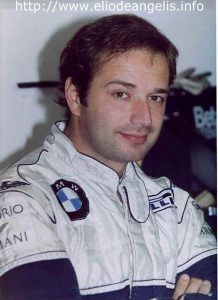
Elio de Angelis was looking forward to being with Brabham, a team that had made him offers earlier in his career and which he felt would suit him better.
However, he insisted “As far as motivation is concerned, I have much more now than when I started. Now I know exactly what I want – I’m not doing this just for the pleasure of driving Formula 1”. He was determined to add more victories to the two he had won with Lotus, and if he had not sincerely believed that he could not get that sort of success with Brabham, he would have given up racing altogether.
Given the radical ‘skateboard’ design of the Brabham BT55 and its lack of testing, those goals seems rather further away than de Angelis had expected in the first four races of the season. At Ricard last Wednesday, however, he and his new team were edging a little closer to the success of which they were so confident, when his car somersaulted off the road through the 170mph ess-bend after the pits. When medical help finally arrived all seemed hopeless. But he hung on for another 30 hours in a Marseille hospital until he succumbed to serious head and chest injuries. He was 28.
Unlike many of today’s single minded drivers, there were genteel non racing facets to de Angelis. Among other things, he was a classical pianist who also adored the compositions of Stevie Wonder. Last year he told me “I think I’m going to stop saying I’m a good musician, because I want to concentrate more on racing. I had a chance to make a record, but I don’t want it to detract from my racing.”
His racing career started with karting in his early teens: he was Italian national champion in 1974 and second in the world championships of 1975. He won the Monaco F3 race in 1978 and for a brief period held a Ferrari contract – which he deliberately dropped in order to join a British F2 team. When he arrived in F1, it was as a renta-driver in 1979 with Ken Tyrrell, who changed his mind about his new signing and promptly found himself on the wrong side of a high court judgement. The de Angelis family money eased the youngster’s way to Shadow, where an amazing performance with a not very good car brought him fourth place and saved Shadow’s FOCA travel expenses for 1980. De Angelis quit, to join Lotus, and promptly found himself in the same legal hot water where he’d left Tyrrell.
The years at Lotus saw a close, almost paternal relationship with Mario Andretti. He had learned English in a matter of months and endeared himself by his loyalty to his new team, which was already on a downturn. But he won a splendid first GP victory in Austria in 1982, beating Keke Rosberg to the line by a tiny margin. The two men were later to become close friends, largely on the basis that they could spend time in each others company without necessarily talking shop. With Lotus fixed up with Turbos in 1983 and eventually back on the bandwagon, de Angelis was a consistent front runner. In 1984 he was the only man who could match the McLarens, and for a short time in 1985 actually lead the World Championship.
Already, though, it was obvious that Ayrton Senna had taken over the number one position in the team which de Angelis had worked so hard to achieve. His mechanic, Nigel Stepney who had followed him from Shadow, said it was a carbon copy of the cold shouldering which Nigel Mansell had suffered a year earlier. Paradoxically, it was Senna who paid one of the sincerest possible tributes to de Angelis when the news of his death was confirmed. “He was a very special sort of driver because he did what he did out of love for the sport, not for any commercial reason. He was well educated, a gentleman, someone who was good to know as a person. I am sure he was not responsible for the accident at Ricard, because he was someone who never went over the limit, who never pushed his luck.”
